Today was the day for Nigwek, a “street festival for an organic PEI,” held along Victoria Row in downtown Charlottetown.
I went down for lunch, had a very nice bowl of noodles, an Island-grown fruit cup (grapes, gooseberries, raspberries) and a glass of fresh lemonade that was everything a glass of fresh lemonade prepared by a chef dressed in whites should be. While I was enjoying my food I also got to listen to a little Meaghan Blanchard and a little Lorne Elliott. The weather was sunny and warm, friends were plentiful, and it was a nice way to spend a bit of a Sunday afternoon.
But here’s the thing: organic agriculture on Prince Edward Island needs a street festival with a weird name and a bunch of burlap-wearing hippies like it needs a hole in the head.
Don’t get me wrong: I love street festivals, I love weird names, and I love burlap-wearing hippies.
But Nigwek, it says, was organized as “a public exhibition for increased attention toward the necessity of PEI becoming more organic.”
And while Nigwek may have been a fun social event for the “organic community,” by closely adhering to the early-adopter back-to-the-land aesthetic that first gave rise to the organic movement (see also brown rice, Birkenstocks, face painting, alfalfa sprouts, juggling, tofu, et al), Nigwek wasn’t very successful at helping to direct attention at the organic issue outside the community of people who already know that it’s in our collective best interest to move the agricultural economy in this direction.
There are many things standing in the way of a more organic Island; one of the foremost is the perception that growing and eating organic is a fringe movement, fine for vegetarians and people who drive Subarus, but far outside the everyday realm of the average Islander.
If anything, an event aimed at drawing “increased attention toward the necessity of PEI becoming more organic” should be bending over backwards to make organics appear like the most regular everyday thing in the world.
Which is to say that the downtown location, the plaintive folksingers and the weird noodles have gotta go.
Do it in the Walmart parking lot. Or in the empty lots beside McDonald’s. Serve regular everyday food that happens to be organic. And for heaven’s sake, give it a name that doesn’t scream “poetic.” Sell the organic idea on its merits, divorced from a lifestyle that, however attractive it may be to you and me, is just plain weird to everyone else.
There’s a strong and lively cultural aspect to the community that’s embraced an organic lifestyle to this point, and I’ve no issue with that being celebrated and strengthened. But it’s limiting to think that to achieve widespread organic food adoption is going to involve (or requires) a parallel widespread organic culture adoption.
It’s time to bring organics out of the yurt and into the bungalow.
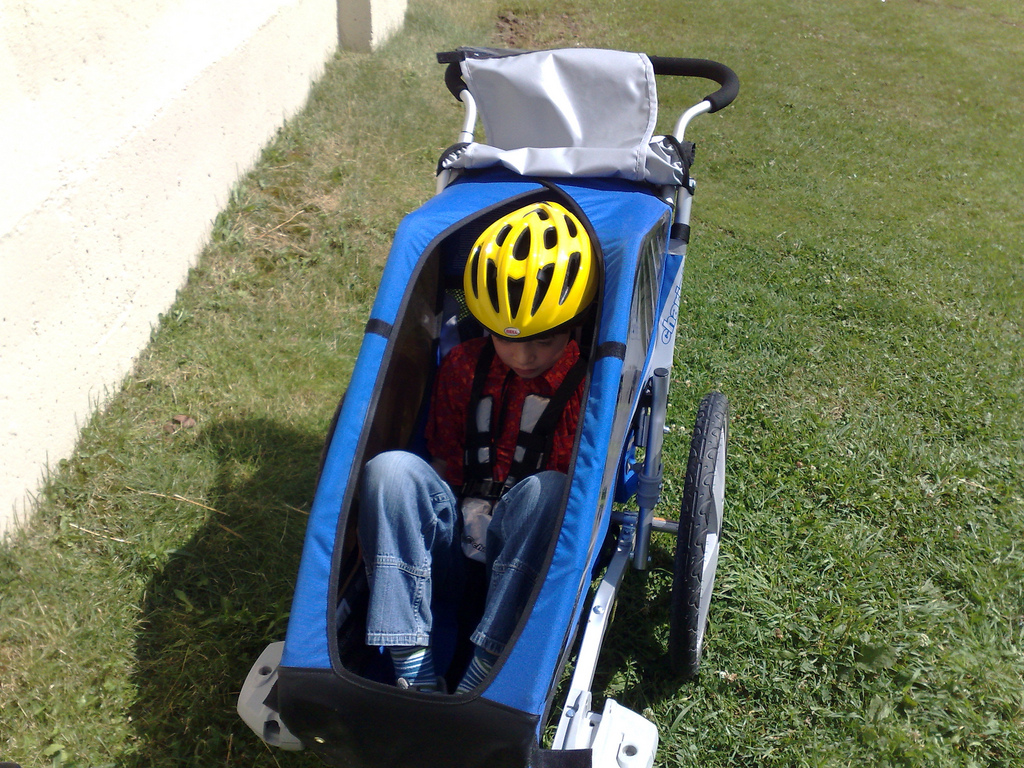 Three years ago, when Oliver was five, we took a trip to the Farmer’s Market by bicycle and trailer. Yesterday, with Oliver seemingly soon to be an adult, I figured it was time to see if he would squeeze into the trailer one last summer. And he did, barely.
Three years ago, when Oliver was five, we took a trip to the Farmer’s Market by bicycle and trailer. Yesterday, with Oliver seemingly soon to be an adult, I figured it was time to see if he would squeeze into the trailer one last summer. And he did, barely.
This time around we rented from Smooth Cycle: $25 a day for chariot rental, with capable, if not overly effusive service. From Smooth Cycle on University Avenue we headed over to Walthen Drive, and then up through the new school sports fields behind Kent Building Supplies, to the Confederation Trail, and up the trail to the Farmer’s Market.
Oliver’s about 20 pounds heavier now that he’s eight, and more than a foot taller, so he didn’t have a lot of room to move around in the chariot, and I had to work 33% harder to move us along, but I managed.
After a stop at the market we headed up the trail to the Charlottetown Mall, in back of Zellers where we stashed the gear behind the A&W and walked across the street to Staples to browse their Nintendo DS games.
Suitably rested, and equipped with a new copy of Petz 2, it was back down the trail — with the wind at our back this time — and, after a few stops, on to Tai Chi Gardens for lunch. By the time we were done lunch we both needed a nap, so we dropped the chariot off at Smooth Cycle and walked home.
Next step: get Oliver on a bicycle of his own.
Last Thursday morning I headed off on my bicycle to Casa Mia for my daily espresso macchiato. When I arrived I noticed that there were bicycles locked to every parking meter on Queen Street had a bicycle locked to it. So I tweeted:

A mere 36 minutes later, the crack investigative team over at CBC Radio One’s Maritime Noon was on the case:
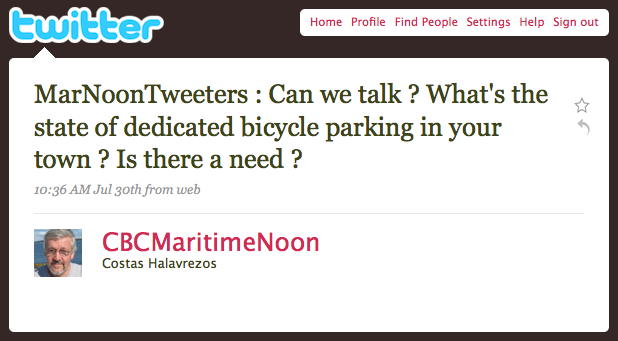
And tomorrow, a week later, the tweet becomes a full-fledged Maritime Noon phone-in:

The lovely irony of this is that three days earlier I found the essay The News About the Internet from The New York Review of Books thanks to a tweet from the selfsame Maritime Noon. The essay includes a quote from New York Times executive editor Bill Keller:
The wonderful florescence of communication ignited by the Internet contains countless voices riffing on the journalism of others but not so many that do serious reporting of their own.
Now I’m as much of a riffer-on-journalism as the next guy, and while it’s hard to claim a “hey, look at all the bicycles” utterance is Serious Reporting, it is nice to see the ecosystem runs both ways.
Tune in to Maritime Noon tomorrow, August 5, 2009, from 12:30 p.m. to 1:00 p.m. Atlantic Daylight Time (live stream) to hear what happens when the utterance gets magnified.
A group of five of us went out to Morell to take the kayak trip on the Morell River that I mentioned last week. It was amazing: unparalleled scenery, calm waters running our way, beautiful weather. This is a trip that anyone can do, whether you’ve kayaked or not and if you’re looking for a great way to spend an afternoon before the snow flies, this is it.
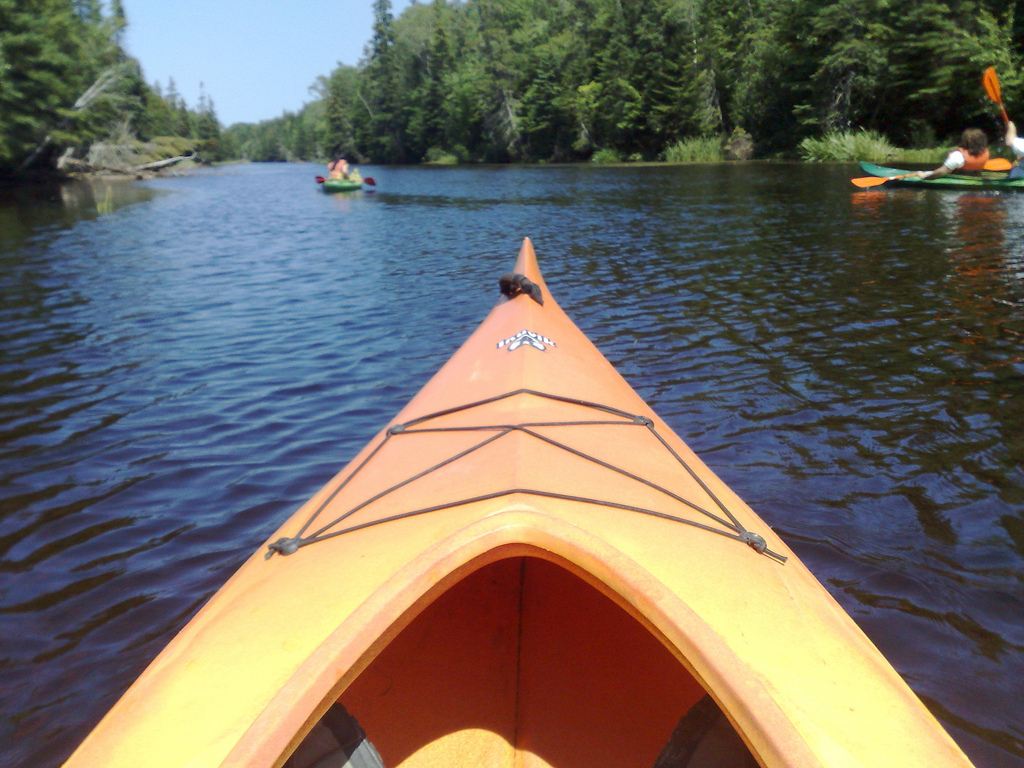
Courtesy of the intriguing tweet me a brief and I will design a logotype for free project, Coworking Boat Pan now has a logo:
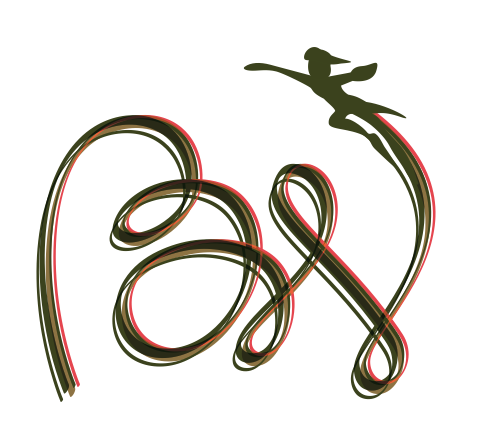
In light of the reported squabbling about the fate of the Experimental Farm in Charlottetown, I’m happy to release my own suggestion for the future of the farm: leave it as it is.
As I learned at the farm’s open house last month, most of the land is currently being used for demonstration crops: if you look carefully on the Belvedere Avenue side of the farm, for example, you can see signs that label the different wheat varieties.
I think this is a good thing: it’s good to have active agriculture happening in full view of urban Islanders. Not only is it good to be exposed to the source of our food, but it’s also an important connection between the urban and rural aspects of Island society.
So forget the convention centres, fire stations, the English country gardens and the “green space” and just leave the farm as, well, a farm.
I’ve begun to experiment a little with using Mapstraction, Drupal module that wraps around it, Cloudmade maps and a Drupal CCK type called Place as a way of storing my personal collection of landmarks. It’s not very elaborate to start, but it works: take a look at ruk.ca/places/map to see how I’ve gotten along. More to follow.
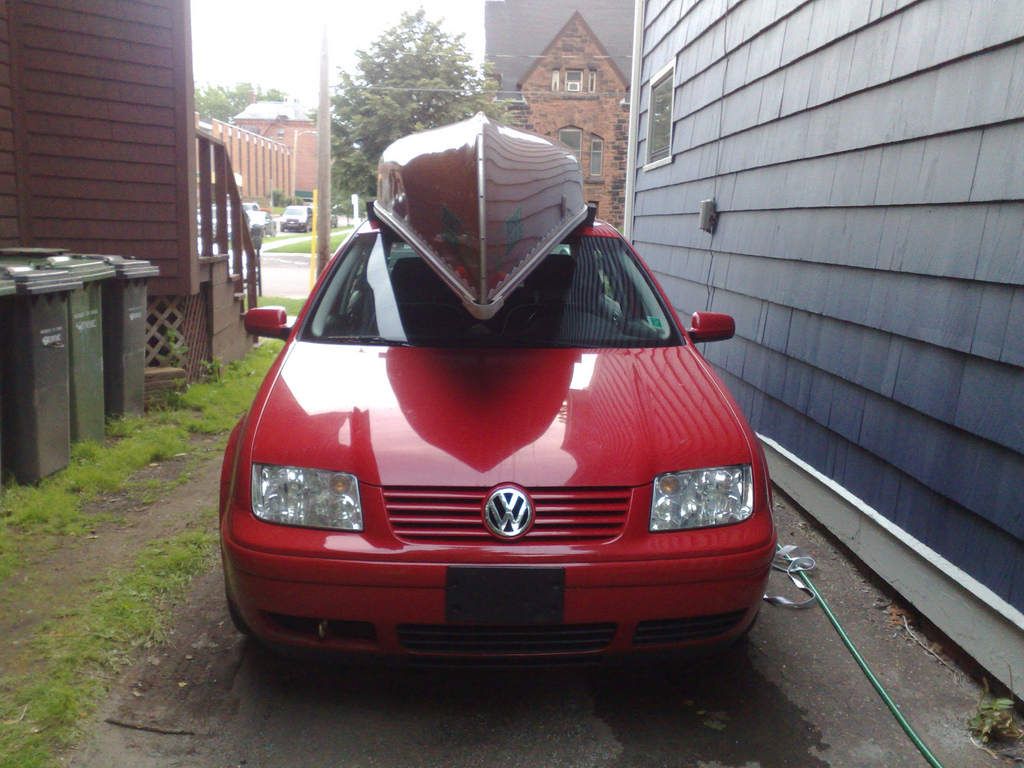 Regular readers may recall that two weeks ago I wrote of my difficulties with securing my canoe to the roof of my car. I’m happy to report that on Thursday afternoon the letter carrier delivered a box of four Rubber Rope Foam Canoe Blocks from Mountain Equipment Coop. With the addition of some cambuckle tie-downs from Canadian Tire we were ready to give things a try.
Regular readers may recall that two weeks ago I wrote of my difficulties with securing my canoe to the roof of my car. I’m happy to report that on Thursday afternoon the letter carrier delivered a box of four Rubber Rope Foam Canoe Blocks from Mountain Equipment Coop. With the addition of some cambuckle tie-downs from Canadian Tire we were ready to give things a try.
As Catherine’s lifting capabilities are temporarily out of commission, it fell to me to get the canoe from the back yard onto the roof of the car. While not directly on-point, this YouTube video was enough to get me started: I got the canoe over my head with the foam blocks already snapped to the gunwales, walked over to the car until the canoe was parallel, set one gunwale’s foam blocks onto the car and then sort of walked/shimmied the canoe into place. With some trial and error it worked; the biggest issue was the foam blocks flipping off and needing to be re-secured during the shimmy.
Once the canoe was on the roof, I ran a 16 foot strap all the way around the canoe’s middle and into the car, securing the cambuckle inside the car and ratcheting it tight. The ratchet mechanism on the cambuckles isn’t obvious to the new eye; it took some trial and error to them to work. The most useful thing I learned is that you should pull through all of the slack before starting to ratchet, rather than just sticking the “tongue” of the loose end in and ratcheting from the start.
With the canoe’s middle secured, I then tied a strap from the rear tow-hook on the Jetta up and around the canoe’s carrying handle and back, again securing the strap with the ratcheting cambuckle.
When I went to do the same on the front of the car I found myself without a tow-hook to secure to; the solution to that problem warranted a blog post all its own.
Once middle, back and front were strapped in, I re-tightened all the straps and the canoe seemed pretty firmly secured to the car’s roof. The only thing I wish I could have changed was that the Jetta has tow hooks only on the passenger side of the car, so that canoe gets pulled to that side (more on this later).
After about an hour of futzing around, we were ready to head out on the water. I’d consulted the excellent book Paddling Prince Edward Island earlier in the day and had decided on Johnstons River as our destination. It wasn’t a long drive, is a freshwater river east of Route 21, and we were promised calm waters and interesting views.
There’s a handy boat ramp on the eastern side of Route 21 on the far side of the river as you drive from town, and I pulled the car down, unloaded the canoe and the gear, and then parked on the side of the highway as the book (and the No Parking signs at the boat launch) suggested.
It was surprisingly easy to get us all into the canoe, considering it was Oliver’s first trip and the first time Catherine and I had been out in almost a decade. Ten minutes after arriving we were paddling upriver; the calm water and interesting views were as promised.
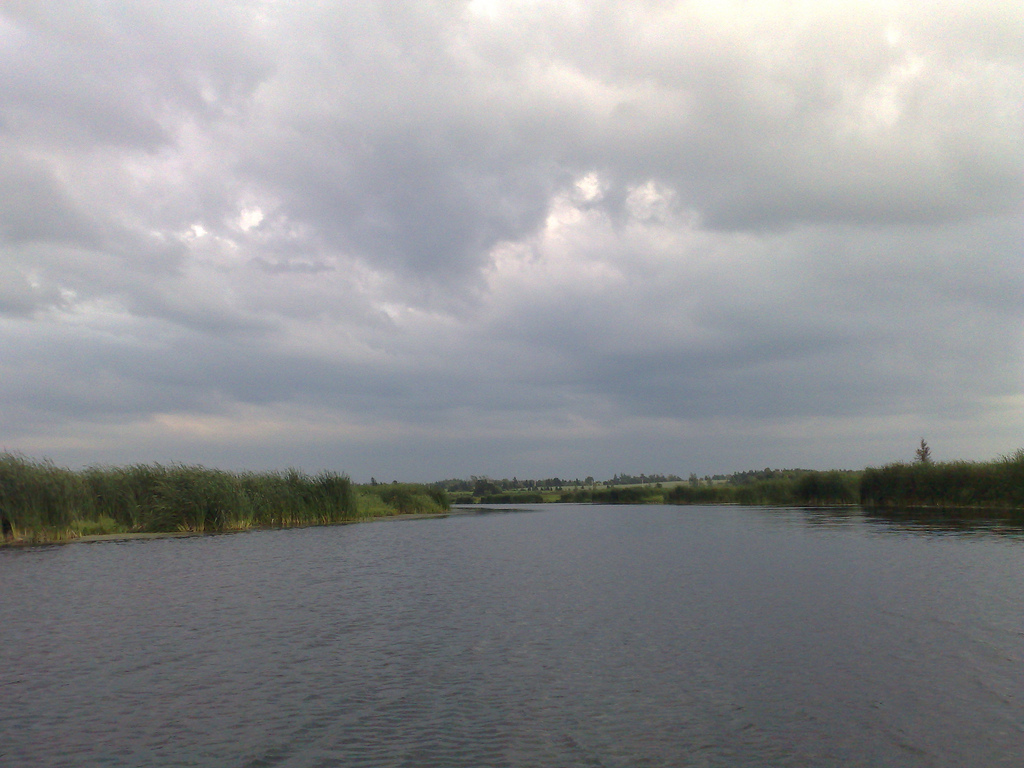
We paddled in about 2 km (map) and then suffered a tiny setback: the rivets holding Catherine’s aluminum seat to the gunwales, no doubt rusted out after a decade of storage in our back shed, gave way. A very-surprised Catherine tumbled to the floor of the canoe, the canoe itself took a dip and let in some water, and Oliver and I looked on in astonishment.
Fortunately Catherine was in one piece when the dust cleared, and although we all got a little wet we were still canoe-worthy and able to make our way back to the car without further incident. Loading the canoe back on the car went quickly, and we were soon back on our way to down.
It wasn’t until we were driving over the Hillsborough River that things got a little hairy again: the wind had picked up and a sudden gust jostled the canoe, naturally pulled to the right by its straps, a few inches over toward the passenger side. It didn’t come off the car, fortunately, but it did prompt me to step and re-secure things and then to drive with my four-way flashers on until we got to the other side. Obviously the canoe-strapping system needs some tweaking if we’re going to go any farther than Johnstons River.
So, canoe experience number one, despite some bumps, was generally positive, and all family members are game to give it another try.
Here’s an something interesting that I stumbled on while searching Google for a Mountain Equipment Coop product number: an ASCII text file listing every product MEC sells. I’m not sure why it’s interesting, but it does make the mind wander into interesting ideas for MEC mashups.
The Charlottetown food explosion continues. Now, joining the Pin Yuan Asian Grocery next to the bus terminal and the Korean Han Gook Convenience Store on the other side of the North River Causeway there’s the new Philippine, African and South Asian Food & Grocery (yes, it’s a long name) on Capital Drive at the back of the Owl’s Hollow building:
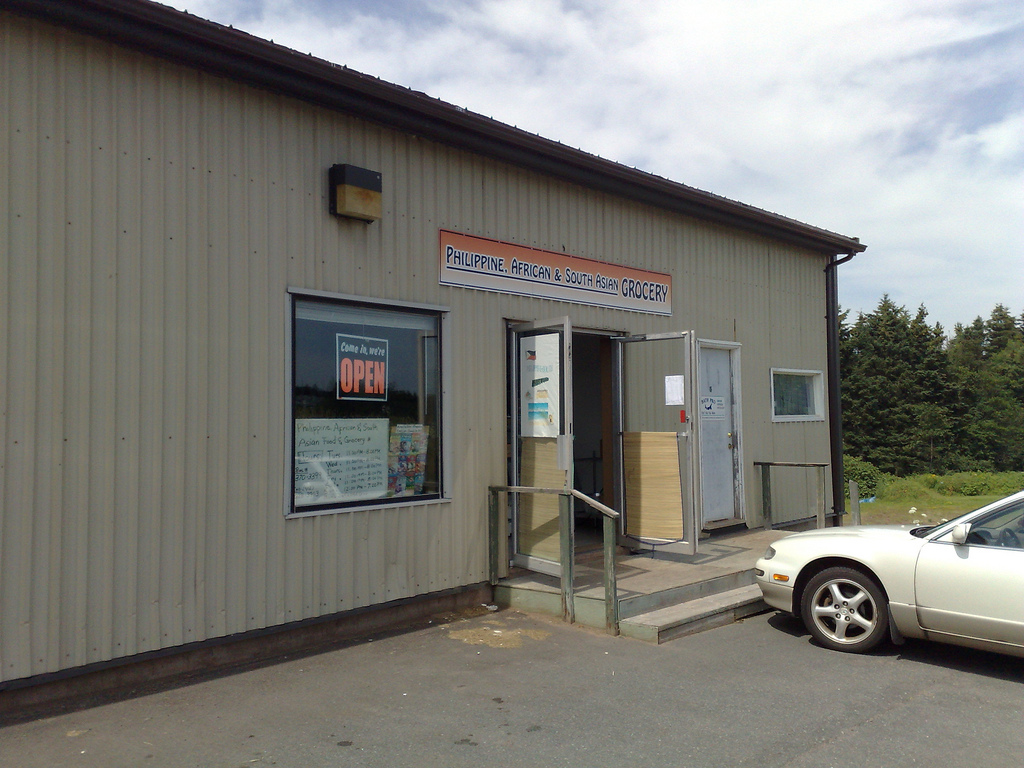
Inside you’ll find a wide variety of food ranging from stuffed bun mix to curry powder to whole coriander to canned squid in ink. It’s a very nice complement to the other stores, and a welcome addition to the city.
They’re open Tuesday through Saturday from 11:00 a.m. to 8:00 p.m. and on Sundays from 12 Noon to 7:00 p.m. You can telephone them at (902) 370-3399.
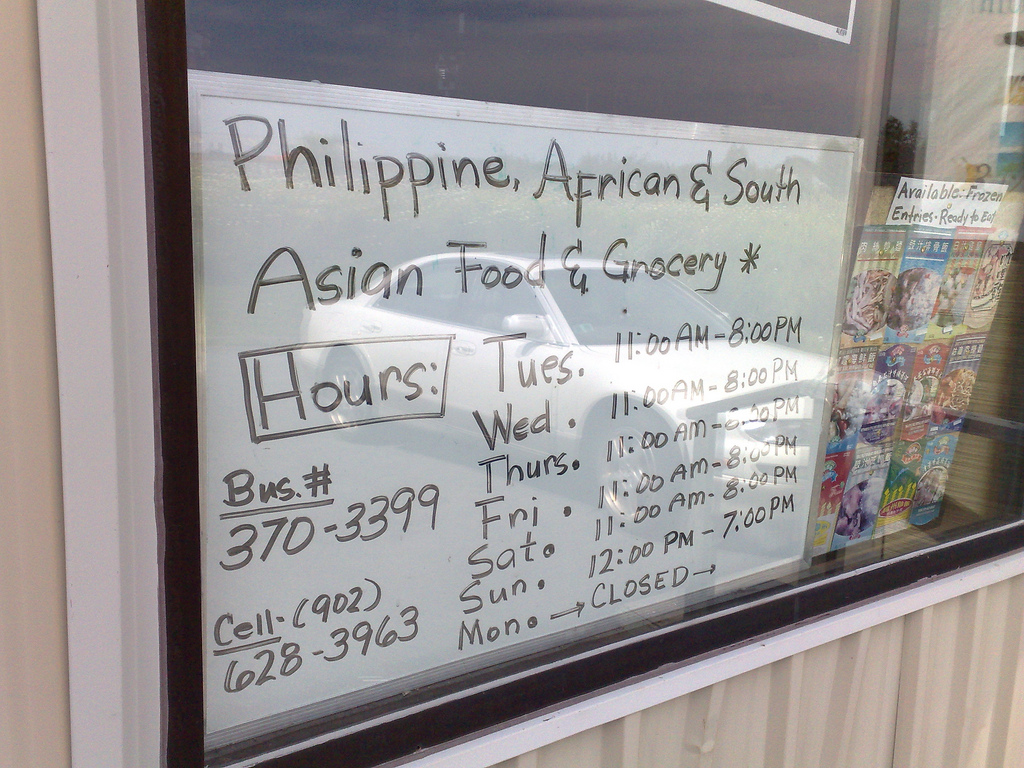
 I am
I am